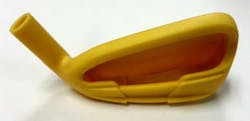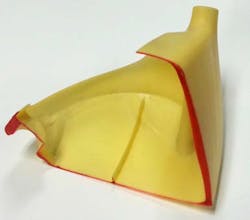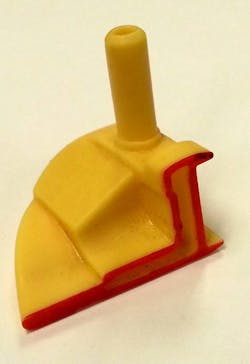An Additive Hole-in-One
Cleveland Golf, founded as Cleveland Classics in 1979, has come a long way since the days of producing replica golf clubs. Headquartered in Huntington Beach, California, the international company has affiliates in three countries and a presence in over twenty others while maintaining a strong sponsorship of champions.
In order to keep up with its strong heritage while also having a mind for the future, Cleveland Golf invested in additive manufacturing during the early millennium.
EnvisionTEC spoke with Dan Nivanh, research and development engineer at Cleveland Golf, who is responsible for running the company’s ULTRA machine.
Nivanh uses the ULTRA DLP along with two other printers to complete rapid prototyping of club heads. According to Nivanh, the company began using 3D printing to cut production costs, but their Objet printer was not allowing them to complete tasks efficiently.
Nivanh sends the builds to a vendor who then makes the final cast. They use Siemens PLM NX, a CAD/CAM software solution, to design the prototype before running the file through Magics to print.
“The benefit on the ULTRA is to have a cleaner print and better resolution as the print comes out, and there’s less print time to get the models printed and have it look realistic. Other printers take longer to do the postprocessing,” said Dan. “It’s very helpful to be able to have that print in-hand versus just showing a digital file printout,” he said.“With the ULTRA we’re able to verify certain features that [the U.S. Patent Office would check or verify]. By just opening up [an STL] file, [the Patent Office] can’t really understand the functionality of the part itself. When they have that print, and they are able to have it in hand, they have a clear understanding of the benefit. We’re able to have [that capability] every single day.” - Dan Nivanh
“We use a model mainly to verify a lot of the designs. We try to use it to prototype the actual part itself, too, to make it castable.“
When Nivanh began working at Cleveland Golf, R&D had a plastic ProJet printer from 3D Systems and a Stratasys Dimension 3D printer for wax models.
“[Because of] the amount of printing that we do, we needed another printer to take some of the load off of the plastic printer, the ProJet itself,” said Dan.
“The ProJet was not as reliable—it was down maybe two times a week—so we needed to look into another printer which was less maintenance and wouldn’t break down as much as the ProJet does.”
The main problem with the production process at the company was that the downtime on printers meant the team had to send their prints to an independent contractor.
“The downtime was crucial to approve the parts,” said Nivanh. This indirect processing due to printer problems frustrated Nivanh until he decided to attend the Pacific Design & Manufacturing Tradeshow in Anaheim, CA. There he met an EnvisionTEC sales representative and learned about the functions, reliability, and print quality of the ULTRA family of printers.
“From what I saw [in Anaheim], the quality of the print was very clean, which is what we’ve liked to put on our models, without having to do any preparation, like sanding it and prepping the surface.”
Dan chose the ULTRA DLP for the quality of the finished parts in addition to feeling comfortable with the technology.
“With the ULTRA, the user is able to debug some of the problems [with a prototype] on-site and able to talk to the tech and walk through it and have the problem fixed in a couple of hours, versus having a tech guy come out here and spend all day on the actual printer trying to get it up and running again. I guess once the user understands the function of the printer they’re able to diagnose the problem itself on-site, so by not having multiple moving parts it tends not to break as often as most printers.”
Nivanh finds that the ULTRA DLP not only performs better than he expected, it also performs better than the main printer he and his team had been using, a ProJet machine.
Nivanh is also pleased with his experience with tech support, though he needed minimal assistance due to the machine’s superior performance. He believes that the minimal moving parts on the ULTRA are what cause his prototypes to materialize with fewer design problems.
“Four years later and it hasn’t broken down yet,” he said. R&D at Cleveland Golf renders and prototypes club heads and drivers through the EnvisionTEC system.
Not only does the team trust a machine to do work where other printers fail, but they also were able to harness a very precise, accurate technology entirely to the benefit of their production process.




